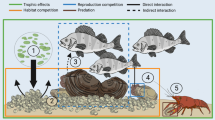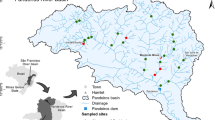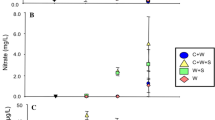Abstract
Large-scale mortality of invasive bivalves was observed in the River Danube basin in the autumn of 2011 due to a particularly low water discharge. The aim of this study was to quantify and compare the biomass of invasive and native bivalve die-offs amongst eight different sites and to assess the potential role of invasive bivalve die-offs as a resource subsidy for the adjacent terrestrial food web. Invasive bivalve die-offs dominated half of the study sites and their highest density and biomass were recorded at the warm water effluent. The density and biomass values recorded in this study are amongst the highest values recorded for aquatic ecosystems and show that a habitat affected by heated water can sustain an extremely high biomass of invasive bivalves. These mortalities highlight invasive bivalves as a major resource subsidy, possibly contributing remarkable amounts of nutrients and energy to the adjacent terrestrial ecosystem. Given the widespread occurrence of these invasive bivalves and the predicted increase in the frequency and intensity of extreme climatic events, the ecological impacts generated by their massive mortalities should be taken into account in other geographical areas as well.





Similar content being viewed by others
References
Balogh, Cs., I. B. Muskó, L. G-Tóth & L. Nagy, 2008. Quantitative trends of zebra mussels in Lake Balaton (Hungary) in 2003–2005 at different water levels. Hydrobiologia 613: 57–69.
Bódis, E., J. Nosek, N. Oertel, B. Tóth, E. Hornung & R. Sousa, 2011a. Spatial distribution of bivalves in relation to environmental conditions (middle Danube catchment, Hungary). Community Ecology 12(2): 210–219.
Bódis, E., J. Nosek, N. Oertel, B. Tóth & Z. Fehér, 2011b. A comparative study of two Corbicula Morphs (Bivalvia, Corbiculidae) inhabiting river Danube. International Review of Hydrobiology 96(3): 257–273.
Boulêtreau, S., J. Cucherousset, S. Villéger, R. Masson & F. Santoul, 2011. Colossal aggregations of giant alien freshwater fish as a potential biogeochemical hotspot. PLoS ONE 6(10): e25732. doi:10.1371/journal.pone.0025732
Cataldo, D. & D. Boltovskoy, 1999. Population dynamics of Corbicula fluminea (Bivalvia) in the Paraná River Delta (Argentina). Hydrobiologia 380: 153–169.
Cherry, D. S., J. L. Scheller, N. L. Cooper & J. R. Bidwell, 2005. Potential effects of Asian clam (Corbicula fluminea) die-offs on native freshwater mussels (Unionidae) I: water-column ammonia levels and ammonia toxicity. Journal of the North American Benthological Society 24(2): 369–380.
Cooper, N. L., J. R. Bidwell & D. S. Cherry, 2005. Potential effects of Asian clam (Corbicula fluminea) die-offs on native freshwater mussels (Unionidae) II: porewater ammonia. Journal of the North American Benthological Society 24(2): 381–394.
Diez, J. M., C. M. D’ Antonio, J. S. Dukes, E. D. Grosholz, J. D. Olden, C. J. B. Sorte, D. M. Blumenthal, B. A. Bradley, R. Early, I. Ibánez, S. J. Jones, J. J. Lawler & L. P. Miller, 2012. Will extreme climatic events facilitate biological invasions? Frontiers in Ecology and the Environment 10(5): 249–257.
French, J. R. & P. W. Schloesser, 1991. Growth and overwinter survival of the Asiatic clam, Corbicula fluminea, in the St. Clair River. Michigan. Hydrobiologia 219: 165–170.
Gagnon, P. M., S. W. Golladay, W. K. Michener & M. C. Freeman, 2004. Drought responses of freshwater mussels (Unionidae) in coastal plain tributaries of the Flint River Basin, Georgia. Journal of Freshwater Ecology 19(4): 667–679.
Galil, B. S., S. Nehring & V. Panov, 2007. Waterways as invasion highways – impacts of climate change and globalization. In Nentwig, W. (ed.), Biological Invasions. Ecological Studies, Vol. 193. Springer, Berlin: 59–74.
Golladay, S. W., P. Gagnon, M. Kearns, J. M. Battle & D. W. Hicks, 2004. Response of freshwater mussel assemblages (Bivalvia: Unionidae) to a record drought in the Gulf Coastal Plain of southwestern Georgia. Journal of the North American Benthological Society 23(3): 494–506.
Gollasch, S. & S. Nehring, 2006. National checklist for aquatic alien species in Germany. Aquatic Invasions 1(4): 245–269.
Gratton, C. & M. J. Vander Zanden, 2009. Flux of aquatic insect productivity to land: comparison of lentic and lotic ecosystems. Ecology 90: 2689–2699.
Hastie, L. C., P. J. Boon, M. R. Young & S. Way, 2001. The effects of a major flood on an endangered freshwater mussel population. Biological Conservation 98: 107–115.
Helfield, J. M. & R. J. Naiman, 2001. Effects of salmon-derived nitrogen on riparian forest growth and implications for stream productivity. Ecology 82: 2403–2409.
Holt, R. D., 2008. Theoretical perspectives on resource pulses. Ecology 89(3): 671–681.
Hornbach, D. J., 1992. Life history traits of a riverine population of the Asian clam Corbicula fluminea. American Midland Naturalist 127: 248–257.
Ilarri, M., C. Antunes, L. Guilhermino & R. Sousa, 2011. Massive mortality of the Asian clam Corbicula fluminea in a highly invaded area. Biological Invasions 13: 277–280.
IPCC, 2007. Climate Change 2007: Synthesis Report, Contribution of Working Groups I, II and III to the Fourth Assessment Report of the Intergovernmental Panel on Climate Change. [Core Writing Team, Pachauri, R. K. & A. Reisinger (eds.)]. IPCC, Geneva, Switzerland: 104 pp.
Kolar, C. S. & D. M. Lodge, 2002. Ecological predictions and risk assessment for alien fishes in North America. Science 298: 1233–1236.
Kraszewski, A. & B. Zdanowski, 2001. The distribution and abundance of the Chinese mussel Anodonta woodiana (Lea, 1834) in the heated Konin Lakes. Archives of Polish Fisheries 9(2): 253–265.
Lodge, D. M., R. A. Stein, K. M. Brown, A. P. Covish, C. Bronmark, J. E. Garvey & S. P. Klosiewki, 1998. Predicting impact of freshwater exotic species on native biodiversity: challenges on spatial scaling. Australian Journal of Ecology 23: 53–67.
Mouthon, J. & M. Daufresne, 2006. Effects of the 2003 heatwave and climatic warming on mollusc communities of the Saône: a large lowland river and of its two main tributaries (France). Global Change Biology 12: 441–449.
Muskó, I. B. & B. Bakó, 2005. The density and biomass of Dreissena polymorpha living on submerged macrophytes in Lake Balaton (Hungary). Archiv für Hydrobiologie 162: 229–251.
NOAA National Climatic Data Center, State of the Climate, 2011. Global Analysis for November 2011, published online December 2011, retrieved on May 30, 2012 from http://www.ncdc.noaa.gov/sotc/global/2011/11.
Polis, G. A., W. B. Anderson & R. D. Holt, 1997. Toward an integration of landscape and food web ecology: the dynamics of spatially subsidized food webs. Annual Review of Ecology Evolution and Systematics 28: 289–316.
R Development Core Team, 2007. A language and environment for statistical computing. R Foundation for Statistical Computing, Vienna, Austria [available on internet at http://www.R-project.org].
Ricciardi, A. & H. J. MacIsaac, 2000. Recent mass invasion of the North American Great Lakes by Ponto-Caspian species. Trends in Ecology & Evolution 15: 62–65.
Simberloff, D., 2011. How common are invasion-induced ecosystem impacts? Biological Invasions 13: 1255–1268.
Smaal, A. C. & A. P. M. A. Vonck, 1997. Seasonal variation in C, N and P budgets and tissue composition of the mussel Mytilus edulis. Marine Ecology Progress Series 153: 167–179.
Sousa, R., J. L. Gutiérrez & D. C. Aldridge, 2009. Non-indigenous invasive bivalves as ecosystem engineers. Biological Invasions 11: 2367–2385.
Sousa, R., P. Morais, E. Dias & C. Antunes, 2011. Biological invasions and ecosystem functioning: time to merge. Biological Invasions 13: 1055–1058.
Sousa, R., S. Varandas, R. Cortes, A. Teixeira, M. Lopes-Lima, J. Machado & L. Guilhermino, 2012. Massive die-offs of freshwater bivalves as resource pulses. Annales de Limnologie – International Journal of Limnology 48: 1–8.
Statsoft Inc., 2001. Statistica 6.0 for Windows (Computer Program Manual). StatSoft, Tulsa, Oklahoma.
Strayer, D. L., 1999. Use of flow refuges by unionid mussels in rivers. Journal of the North American Benthological Society 18(4): 468–476.
Strayer, D. L., 2010. Alien species in fresh waters: ecological effects, interactions with other stressors, and prospects for the future. Freshwater Biology 55(Supplement 1): 152–174.
Strayer, D. L. & H. M. Malcom, 2007. Shell decay rates of native and alien freshwater bivalves and implications for habitat engineering. Freshwater Biology 52: 1611–1617.
Vaughn, C. C. & C. C. Hakenkamp, 2001. The functional role of burrowing bivalves in freshwater ecosystems. Freshwater Biology 46: 1431–1446.
Vaughn, C. & C. M. Taylor, 1999. Impoundments and the decline of freshwater mussels: a case study of an extinction gradient. Conservation Biology 13: 912–920.
Werner, S. & K. O. Rothhaupt, 2008. Mass mortality of the invasive bivalve Corbicula fluminea induced by a severe low-water event and associated low water temperatures. Hydrobiologia 613: 143–150.
Wipfli, M. S., J. Hudson & J. Caouette, 1998. Influence of salmon carcasses on stream productivity: response of biofilm and benthic macroinvertebrates in southeastern Alaska, U.S.A. Canadian Journal of Fisheries and Aquatic Sciences 55: 1503–1511.
Yang, L. H., J. L. Bastow, K. O. Spence & A. N. Wright, 2008. What can we learn from resource pulses? Ecology 89(3): 621–634.
Acknowledgements
The authors are grateful to David Strayer for valuable comments on a previous version of the manuscript. Special thanks to the Danube-Ipoly National Park for the help in field work. Ronaldo Sousa was supported by the project “ECO-IAS” funded by the Portuguese Foundation for the Science and the Technology and COMPETE funds (contract: PTDC/AAC-AMB/116685/2010).
Author information
Authors and Affiliations
Corresponding author
Additional information
Guest editors: Manuel P. M. Lopes-Lima, Ronaldo G. Sousa, Simone G. P. Varandas, Elsa M. B. Froufe & Amílcar A. T. Teixeira / Biology and Conservation of Freshwater Bivalves
Rights and permissions
About this article
Cite this article
Bódis, E., Tóth, B. & Sousa, R. Massive mortality of invasive bivalves as a potential resource subsidy for the adjacent terrestrial food web. Hydrobiologia 735, 253–262 (2014). https://doi.org/10.1007/s10750-013-1445-5
Received:
Accepted:
Published:
Issue Date:
DOI: https://doi.org/10.1007/s10750-013-1445-5




